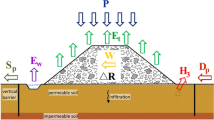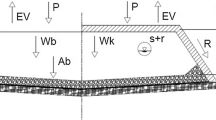Abstract
A landfill was designed to evaluate leachate quantity’s governing factors using the HELP model. As a case study, the proposed methodology was tested in the Nazlou Landfill, Urmia, Iran. Indeed, the main objective was to illuminate the efficacy of executive parameters defined in the model. Lack of the final cover layer in the pre-closure period affects leachate generation as precipitation enters directly into the waste layers and changes their moisture constituents. Concerning the occurrence of the heaviest precipitation condition in the last 30 years in the pre-closure period, leachate leakage might increase to 0.23 m3/tonne of waste. Due to changes in the layers’ initial moisture, the effect of precipitation on leachate generation lasts till the landfill post-closure and would change the drained leachate from 0.083 to 0.089 m3/year-tonne of waste (this amount is generally neglected in the leachate collection system design). During pre-closure, the heaviest precipitation causes an increased generated leachate by 37.59% in the first post-closure year, which is vital especially in landfills with limited capacity treatment plants. The impact of operating conditions involves the landfill leachate generation up to different years. However, over five years of averaging, the precipitation trend was consistent with the leachate leakage. Based on the different scenarios defined regarding the meteorological conditions and design parameters, if the geomembrane layer was removed from the final cover, the leachate quantity will be increased by 79.38%. Replacing 76 cm of dense clay can overcome this challenge.
Graphical abstract





Similar content being viewed by others
Data availability
The datasets generated during and/or analyzed during the current study are available from the corresponding author on reasonable request.
Change history
28 February 2022
A Correction to this paper has been published: https://doi.org/10.1007/s10661-022-09779-y
References
Abdalqader, A., & Hamad, J. (2012). Municipal solid waste composition determination supporting the integrated solid waste management in Gaza strip. International Journal of Environmental Science and Development, 3(2), 172. https://doi.org/10.7763/IJESD.2012.V3.210
Abunama, T., Othman, F., Alslaibi, T., & Abualqumboz, M. (2017). Quantifying the generated and percolated leachate through a landfill’s lining system in Gaza Strip Palestine. Polish. Journal of Environmental Studies, 26(6), 2455–2461. https://doi.org/10.15244/pjoes/73803
Abunama, T., Othman, F., Ansari, M., & El-Shafie, A. (2019). Leachate generation rate modeling using artificial intelligence algorithms aided by input optimization method for an MSW landfill. Environmental Science and Pollution Research, 26(4), 3368–3381.
Agwu, M. O. (2012). Issues and challenges of solid waste management practices in Port-Harcourt City, Nigeria—A behavioural perspective. American Journal of Social and Management Sciences, 3(2), 83–92. https://doi.org/10.5251/ajsms.2012.3.2.83.92
Aljaradin, M., & Persson, K. M. (2013). Proposed water balance equation for municipal solid waste landfills in Jordan. Waste Management & Research, 31(10), 1028–1034. https://doi.org/10.1177/0734242X13492003
Alimohammadi, P., Shariatmadari, N., Abdoli, M. A., Ghiasinejad, H., & Mansouri, A. (2010). Analysis of Help Model Application in semi-arid areas, study on Tehran test cells. International Journal of Civil Engineering, 8(2), 174–186.
Allen, R. G., Pereira, L. S., Raes, D., & Smith, M. (1998). Crop evapotranspiration—Guidelines for computing crop water requirements-FAO Irrigation and drainage paper 56. Fao, Rome, 300(9), D05109.
Alslaibi, T. M., Abustan, I., Mogheir, Y. K., & Afifi, S. (2013). Quantification of leachate discharged to groundwater using the water balance method and the Hydrologic Evaluation of Landfill Performance (HELP) model. Waste Management & Research., 31(1), 50–59. https://doi.org/10.1177/0734242X12465462
ASTM D 5231–92 (Reapproved 2003). (2003). Standard test method for determination of the composition of unprocessed municipal solid waste. ASTM International, 6.
Berger, K. U. (2015). On the current state of the Hydrologic Evaluation of Landfill Performance (HELP) model. Waste Management, 38, 201–209. https://doi.org/10.1016/j.wasman.2015.01.013
Central Public Health & Environmental Engineering Organization (CPHEEO). (2000). Manual on Municipal Solid Waste Management. Ministry of Housing and Urban Affairs Government of India.
Chabuk, A., Al-Ansari, N., Alkaradaghi, K., Al-Rawabdeh, A. M. M., Laue, J., Hussain, H. M., Roland, P., & Knutsson, S. (2018a). Landfill final cover systems design for arid areas using the HELP model: A case study in the Babylon Governorate, Iraq. Sustainability, 10(12), 4568. https://doi.org/10.3390/su10124568
Chabuk, A., Al-Ansari, N., Ezz-Aldeen, M., Laue, J., Pusch, R., Hussain, H. M., & Knutsson, S. (2018b). Two scenarios for landfills design in special conditions using the HELP model: A case study in Babylon Governorate, Iraq. Sustainability, 10(1), 125. https://doi.org/10.3390/su10010125
Cline, C., Anshassi, M., Laux, S., & Townsend, T. G. (2020). Characterizing municipal solid waste component densities for use in landfill air space estimates. Waste Management & Research, 38(6), 673–679. https://doi.org/10.1177/0734242X19895324
Das, S., & Bhattacharyya, B. K. (2014). Estimation of municipal solid waste generation and future trends in greater metropolitan regions of Kolkata, India. Journal of Industrial Engineering and Management Innovation, 1(1), 31–38. https://doi.org/10.2991/jiemi.2014.1.1.3
Fatta, D., Papadopoulos, A., & Loizidou, M. (1999). A study on the landfill leachate and its impact on the groundwater quality of the greater area. Environmental Geochemistry and Health, 21(2), 175–190. https://doi.org/10.1023/A:1006613530137
Frikha, Y., Fellner, J., & Zairi, M. (2017). Leachate generation from landfill in a semi-arid climate: A qualitative and quantitative study from Sousse Tunisia. Waste Management & Research, 35(9), 940–948. https://doi.org/10.1177/0734242X17715102
Geo-Slope. (2018). GeoStudio. Available at: https://www.geoslope.com/products/geostudio. Accessed at January 2018.
Ghaffariraad, M., & Ghanbarzadeh Lak, M. (2021). Landfill leachate treatment through coagulation-flocculation with lime and bio-sorption by walnut-shell. Environmental Management, 1–14. https://doi.org/10.1007/s00267-021-01489-4
Ghanbarzadeh Lak, M., Sabour, M. R., Ghafari, E., & Amiri, A. (2018). Energy consumption and relative efficiency improvement of Photo-Fenton–Optimization by RSM for landfill leachate treatment, a case study. Waste Management., 79, 58–70. https://doi.org/10.1016/j.wasman.2018.07.029
Ibrahim, T. N. T., Mahmood, N. Z., & Othman, F. (2017). Estimation of leachate generation from MSW landfills in Selangor. Environmental Science., 19(1), 43–48.
Iran Meteorological Organization. (2019). Iran Meteorological Organization Portal. Available at: http://www.irimo.ir/. Accessed at January 2019.
Jaramillo, J. (2003). Guidelines for the design, construction and operation of manual sanitary landfills. Pan American Center for Sanitary Engineering and Environmental Science.
Jemec, A., Tišler, T., & Žgajnar-Gotvajn, A. (2012). Assessment of landfill leachate toxicity reduction after biological treatment. Archives of Environmental Contamination and Toxicology, 62(2), 210–221. https://doi.org/10.1007/s00244-011-9703-x
Karabulut, A. İ., Yazici-Karabulut, B., Derin, P., Yesilnacar, M. I., & Cullu, M. A. (2021a). Landfill siting for municipal solid waste using remote sensing and geographic information system integrated analytic hierarchy process and simple additive weighting methods from the point of view of a fast-growing metropolitan area in GAP area of Turkey. Environmental Science and Pollution Research, 1–18. https://doi.org/10.1007/s11356-021-15951-7
Karabulut, B. Y., Derin, P., Yeşilnacar, M. İ., & Çullu, M. A. (2021b). A study on evaluation of site selection in sanitary landfill with regard to urban growth. Environmental Research and Technology, 4(2). https://doi.org/10.35208/ert.841200
Meegoda, J. N., Hettiarachchi, H., & Hettiaratchi, P. (2016). Landfill design and operation. Sustainable Solid Waste Management, 577–604.
Moody, C. M., & Townsend, T. G. (2017). A comparison of landfill leachates based on waste composition. Waste Management, 63, 267–274. https://doi.org/10.1016/j.wasman.2016.09.020
Nakhaei, M., Amiri, V., Rezaei, K., & Moosaei, F. (2015). An investigation of the potential environmental contamination from the leachate of the Rasht waste disposal site in Iran. Bulletin of Engineering Geology and the Environment, 74(1), 233–246. https://doi.org/10.1007/s10064-014-0577-9
O’leary, P. R., Tchobanoglous, G., & Kreith, F. (2002). Handbook of solid waste management: Landfilling. McGraw-Hill.
Pantini, S., Verginelli, I., & Lombardi, F. (2014). A new screening model for leachate production assessment at landfill sites. International Journal of Environmental Science and Technology, 11(6), 1503–1516. https://doi.org/10.1007/s13762-013-0344-7
Qasim, S. R., & Chiang, W. (1994). Sanitary landfill leachate: Generation, control, and treatment. CRC Press.
Renou, S., Givaudan, J. G., Poulain, S., Dirassouyan, F., & Moulin, P. (2008). Landfill leachate treatment: Review and opportunity. Journal of Hazardous Materials, 150(3), 468–493. https://doi.org/10.1016/j.jhazmat.2007.09.077
Renou, S., Poulain, S., Givaudan, J. G., Sahut, C., & Moulin, P. (2009). Lime treatment of stabilized leachates. Water Science and Technology, 59(4), 673–685. https://doi.org/10.2166/wst.2009.014
Rhyner, C. R., Schwartz, L. J., Wenger, R. B., & Kohrell, M. G. (1995). Waste management and resource recovery (1st ed.). CRC-Press.
Schroeder, P.R., Aziz, N., Lloyd, C., & Zappi, P. (1994). The hydrologic evaluation of landfill performance (HELP) model: user’s guide for version 3: Risk Reduction Engineering Laboratory, Office of Research and Development.
Shroff, V. S. (1999). An investigation of leachate production from MSW landfills in semi-arid climates. The University of Calgary. http://dx.doi.org/10.11575/PRISM/12995
Sivakumar, D. (2013). Experimental and analytical model studies on leachate volume computation from solid waste. International Journal of Environmental Science and Technology, 10(5), 903–916. https://doi.org/10.1007/s13762-012-0083-1
Statistical Center of Iran. (2020). Statistical Center of Iran Portal. Available at: https://www.amar.org.ir/english. Accessed at January 2020.
Tatsi, A., & Zouboulis, A. (2002). A field investigation of the quantity and quality of leachate from a municipal solid waste landfill in a Mediterranean climate (Thessaloniki, Greece). Advances in Environmental Research, 6(3), 207–219. https://doi.org/10.1016/S1093-0191(01)00052-1
Tolaymat, T., & Krause, M. (2020). The hydrologic evaluation of landfill performance (HELP) model: user manual for version 4.0. Homeland Security Research Program, Office of Research and Development.
U.S.EPA. (2017). Hydrologic Evaluation of Landfill Performance (HELP) Model. Available from: https://www.epa.gov/land-research/hydrologic-evaluation-landfill-performance-help-model. Accessed at January 2019.
Wang, Z. P., Zhang, Z., Lin, Y. J., Deng, N. S., Tao, T., & Zhuo, K. (2002). Landfill leachate treatment by a coagulation–photooxidation process. Journal of Hazardous Materials, 95(1–2), 153–159. https://doi.org/10.1016/S0304-3894(02)00116-4
Wuana, R. A., & Okieimen, F. E. (2011). Heavy metals in contaminated soils: A review of sources, chemistry, risks and best available strategies for remediation. International Scholarly Research Notices, 2011. https://doi.org/10.5402/2011/402647
Xu, Q., Kim, H., Jain, P., & Townsend, T. G. (2012). Hydrologic evaluation of landfill performance (HELP) modeling in bioreactor landfill design and permitting. Journal of Material Cycles and Waste Management, 14(1), 38–46. https://doi.org/10.1007/s10163-011-0035-8
Yalcin, F., & Demirer, G. (2002). Performance evaluation of landfills with the HELP (hydrologic evaluation of landfill performance) model: Izmit case study. Environmental Geology, 42(7), 793–799. https://doi.org/10.1007/s00254-002-0582-3
Yang, N., Damgaard, A., Kjeldsen, P., Shao, L. M., & He, P. J. (2015). Quantification of regional leachate variance from municipal solid waste landfills in China. Waste Management, 46, 362–372. https://doi.org/10.1016/j.wasman.2015.09.016
Yesilnacar, M. I., & Cetin, H. (2005). Site selection for hazardous wastes: A case study from the GAP area Turkey. Engineering Geology, 81(4), 371–388. https://doi.org/10.1016/j.enggeo.2005.07.012
Yesilnacar, M. I., & Cetin, H. (2008). An environmental geomorphologic approach to site selection for hazardous wastes. Environmental Geology, 55(8), 1659–1671. https://doi.org/10.1007/s00254-007-1115-x
Yesilnacar, M. I., Süzen, M. L., Kaya, B. Ş, & Doyuran, V. (2012). Municipal solid waste landfill site selection for the city of Şanliurfa-Turkey: An example using MCDA integrated with GIS. International Journal of Digital Earth, 5(2), 147–164. https://doi.org/10.1080/17538947.2011.583993
Author information
Authors and Affiliations
Corresponding author
Ethics declarations
Competing interests
The authors declare no competing interests.
Additional information
Publisher's Note
Springer Nature remains neutral with regard to jurisdictional claims in published maps and institutional affiliations.
Highlights
• Introducing a new method in using the HELP model to estimate leachate quantity.
• Minimizing the leachate volume estimation error by modifying the HELP input data.
• Analysis of MSW composition and presentation of a landfill conceptual design.
• Investigation of the hydrological condition of the pre-closure period on leachate generation.
• Assessing precipitation effect as the most significant factor on leachate generation rate.
• Moving towards sanitary–economical landfill design by removing the geomembrane layer.
Supplementary Information
Below is the link to the electronic supplementary material.
Rights and permissions
About this article
Cite this article
Ghaffariraad, M., Ghanbarzadeh Lak, M. & Ebrahimi Sarindizaj, E. Sensitivity analysis of significant parameters affecting landfill leachate generation rate. Environ Monit Assess 194, 12 (2022). https://doi.org/10.1007/s10661-021-09653-3
Received:
Accepted:
Published:
DOI: https://doi.org/10.1007/s10661-021-09653-3




